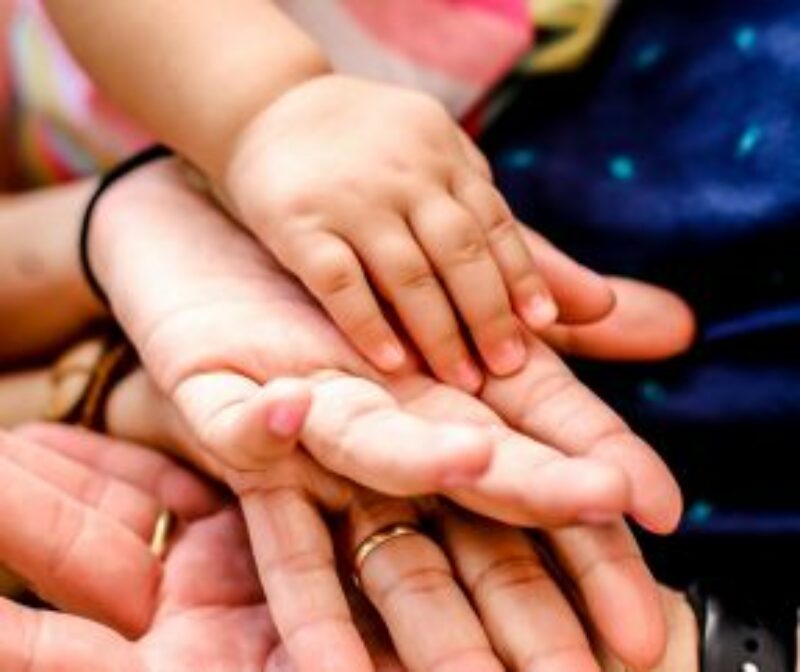This is Part 3 of a 3-part series.
I Want to Know What Love Is!
In my last two blog posts, we examined why we need relationships and how loving relationships affect us. I introduced you to the safe haven function of love and broke down the first three qualities of love: Proximal Responsiveness, Sensitivity, and Repair. If you are endlessly confused, you likely haven’t read my first two posts, and I would direct you to get caught up on my first post here and my second post here. In this final post, I will outline the Secure Base function of love and dive into the final three qualities: Differentiation, Cooperation, and Encouragement. I will use a similar structure to my last post by defining the qualities first and then providing real-life examples and prompts for how you can start bringing these into your own relationships.
The Secure Base Function
So, to dive right in, I want to return to our metaphor of the root system of trees that has spanned this series. As humans, we are meant to be deeply “rooted” in relationships with others, sharing life-giving nutrients with one another. In my last post, we discussed the three qualities of the safe haven functions of love. These love nutrients provide comfort, protection, and emotional support when a loved one is in distress. Today, our focus is on the secure base function of love. This function of love encapsulates the nutrients that promote growth. It’s a powerful kind of love that doesn’t cling or control, but rather supports from a grounded, steady place, communicating love, support, and joy over the uniqueness of the other. Just as a healthy root system empowers a tree to grow into the unique tree they are meant to be, secure base love supports those we care for to develop the courage to become more fully themselves. In other words (to reference the title) I grow “Because You Love Me”. 😉
The Secure Base Qualities of Loving Relationships
Differentiation
The term differentiation might sound a little academic, but what it’s really getting at is something deeply human: my ability to stay grounded in my own emotional experience while staying present with someone I care about, without getting swept up in their feelings or losing track of my own. It’s about recognizing, “This is your struggle, and this is my reaction to your struggle,” and not confusing the two. It’s especially important when the people we love are hurting and we want to help, but helping turns into over-involvement. Or worse—resentment. Sound familiar?
Let’s look at how this might show up in a parenting moment. Imagine a caregiver watching their child wrestle with a frustrating homework assignment. The child might be struggling—groaning, maybe even tearing up. The parent feels that tightening in their chest, that urge to jump in and fix it immediately. But maybe underneath that urge is something else: a fear of failure, memories of their own academic struggles, or anxiety about their child’s future. Differentiation is the parent’s ability to pause and think, “Wait, this frustration belongs to my child. My job is to support, not take over. My feelings are valid, but they don’t have to run the show.” So instead of micromanaging or swooping in to do the work themselves, the parent might say, “I see you’re really frustrated—want to take a break or talk through the next step together?” The key is being able to notice both sets of emotions—their child’s and their own—and respond thoughtfully rather than reactively.
A lack of differentiation can show up not only in moments of distress, but also during times of change or when things don’t unfold as we expect. In adult romantic relationships, this might occur when your partner is pursuing something new: a career opportunity, a creative project, or a personal goal that excites them. Without healthy differentiation, their growth can trigger anxiety. Instead of celebrating their expansion, you might subtly discourage them—questioning their decision, pointing out risks, or even feeling abandoned by their excitement. This isn’t usually out of malice; more often, it stems from a fear of disconnection. But when we blur the line between our emotional needs and theirs, we risk holding them back in an effort to protect our own sense of security. Differentiation means recognizing: “Their growth doesn’t threaten me—it’s part of who they are.” It allows us to stay connected and supportive, even as our partner stretches into something new.
Practice:
So how can you begin practicing differentiation in your relationships—whether in times of distress or during seasons of change? First, when you notice yourself wanting to react from a strong emotional place, slow down. Pause before responding. Second, get curious about what you’re feeling and what the other person is feeling. Ask yourself, “Is this emotion mine, theirs, or a mix of both?” Third, let that awareness guide your response. For example, if your emotion is rooted in fear from past experiences, take a breath and reflect on how that fear might be influencing you to respond in a way that isn’t helpful. Finally, whether your loved one is struggling or growing, sometimes the most loving thing you can do is simply stay present—without over-identifying, over-functioning, or trying to control the outcome. Differentiation is a form of emotional maturity that says, “I can walk with you through this—but I can’t carry it for you.” It’s the balance between compassion and clarity, empathy and emotional boundaries. It’s the quiet confidence of saying, “I’m here. I care. And I know where I end and you begin.”
When we’re able to remain lovingly differentiated, we communicate both respect and belief: that our loved one is capable, that they can face what’s in front of them, and that we trust in their strength. That kind of love builds self-confidence—and it helps relationships grow stronger, too.
Cooperation
At its heart, cooperation is about coming alongside someone—not charging ahead or pulling them in your direction, but working with them in a way that respects their style, preferences, and pace. It’s the difference between saying, “Here’s how I’d fix it,” and asking, “How do you want to approach this—and how can I support that?”
Let’s make this a little more concrete. Imagine a parenting moment where your teenager is struggling with how to manage their time—maybe they’ve got a big assignment due, basketball practice after school, and a messy room that’s stressing them out. You see the chaos and want to swoop in with your proven system—time blocks, checklists, maybe even doing parts of it for them. But cooperation isn’t about taking over. It’s about pausing to ask, “What’s your plan here? Do you want help thinking through it?” It might mean sitting down and brainstorming with them, even if their process feels slower or messier than yours. True cooperation means respecting that they might do things differently and offering help that supports their way, not yours.
In adult relationships, cooperation might look like your partner facing a tough decision—maybe dealing with a conflict at work or figuring out how to support a friend in crisis. You might have a clear opinion or think you know the best path. But instead of pushing your approach, cooperation is about listening first. You might say, “What are you thinking about doing?” or “Do you want me to weigh in, or just be here while you talk it out?” The goal is to support—not steer. You’re not trying to shape their process into your own image but holding space for their wisdom, trusting that they are the expert on themselves, and so it is only right that they take the lead.
When we cooperate in this way, it has a powerful effect on the other person. It reinforces their sense of agency, reminding them that their voice matters and their process is valid. Rather than feeling managed or dismissed, they feel seen, respected, and trusted. And when someone feels trusted, they’re more likely to trust themselves. Cooperation isn’t just a strategy for getting things done together—it’s a way of fostering confidence, connection, and mutual respect.
Practice:
To start practicing cooperation in your relationships, first, notice when your instinct is to jump in and take charge. That impulse often comes from a good place—a desire to help, protect, and move things forward. But pause and ask, “What would support look like for them, not just for me?” Second, make room for differences. The people we love often think, feel, and operate differently than we do—and cooperation means honoring that. And finally, remember that collaboration isn’t passivity. It’s active, thoughtful, and flexible. It’s the posture of saying, “I trust your way of approaching this, and I want to be a teammate, not a director.” When we lead with curiosity and humility, cooperation becomes less about control and more about connection.
Encouragement
At its core, encouragement is about recognizing and uplifting the unique spark in someone you love. It’s about seeing their gifts, dreams, creativity—even the ones that feel far-fetched or unfamiliar to you—and choosing to celebrate them instead of questioning or redirecting them. Encouragement isn’t just praise; it’s a way of being that says, “I see you, and I believe in what makes you, *you*.”
Let’s break this down a little more. Think about it in a parenting context. Say your child comes to you with a wild idea—they want to write a comic book series, build a spaceship out of cardboard, or become a professional juggler. It might not make perfect sense to you, and part of you might want to steer them toward something more “realistic” or “productive.” But encouragement asks something different of us: to lean in and say, “That sounds amazing—tell me more!” It doesn’t mean you have to know where the dream is going. It means you offer your attention, excitement, and maybe even a little practical support, simply because they care about it. When we uplift their efforts and imagination, we’re telling them their inner world matters—and that we delight in who they are becoming.
In adult relationships, encouragement might look like noticing when your partner lights up, talking about a new idea or passion—maybe it’s a creative project, a business idea, or a personal goal they’ve been quietly mulling over. Encouragement means making space for that part of them to breathe. It’s saying, “That sounds important to you—how can I support you?” or “I love seeing you excited about this.” It’s also resisting the urge to play devil’s advocate too soon or to inject your fears or preferences (building on Differentiation!). Encouragement is not about managing their dreams; it’s about standing beside them as a fan, an ally, and a witness to their growth.
Practice:
So, how do you start practicing encouragement in your relationships? First, listen for the spark. Pay attention to the things that bring your loved one alive—those little glimmers of excitement or longing. Second, reflect back what you see. A simple “I love that you care so much about this” can go a long way. And finally, check in with your own reactions. If you find yourself wanting to redirect, pause, and ask yourself, “Am I encouraging their uniqueness, or trying to make them more like me?” Encouragement lives in that powerful space between support and autonomy—it’s the art of championing someone as they are, not as you wish them to be.
Summary
When we show up in our relationships with Differentiation, Cooperation, and Encouragement, we support what psychologists refer to as the secure base function of caregiving. This secure base allows our loved ones to grow, take healthy risks, and confidently move toward their goals—because they know we’re in their corner, cheering them on without trying to control their path. Using the root system metaphor, these qualities are like nutrients exchanged between trees not just in times of distress, but during seasons of expansion. Differentiation helps us stay emotionally grounded, honoring where we end and the other begins. Cooperation invites us to walk with our loved one, rather than pulling them in our direction. And encouragement is the sunlight that helps growth happen—it says, “I see your potential, and I believe in you.” Over time, these practices foster inner security, emotional flexibility, and trust in the relationship and oneself. These relational nutrients are also linked to higher levels of purpose in life, creativity, goal-directedness, and self-esteem. It truly is, because we are loved that we are able to grow, thrive, and become uniquely ourselves while being rooted in connection.
Conclusion
In this three-part series, we’ve explored the central role that relationships play in shaping who we are and who we are becoming. From the grounding qualities of a safe haven—proximal responsiveness, sensitivity, and repair—to the empowering dynamics of a secure base—differentiation, cooperation, and encouragement—we’ve seen how love, when offered with intention and care, becomes a powerful force for growth. These qualities don’t just support our well-being in the moment; they create the conditions for deep-rooted trust, emotional resilience, and generative connection. Because just like trees in a thriving forest, we’re not meant to grow alone. We’re meant to give and receive love within a resilient, mutual network of Reciprocating Love. And when we do—when we offer and receive these relational nutrients—we become more fully ourselves. Stronger. Softer. And more deeply alive. All because you loved me.
Continue Exploring

Love
What’s Love Got to Do with It? Possibly, Everything!
Thrive Fellow, Rebecca Baer, explains why loving relationships are central to thriving and the qualities we need to get and give love.

Love
I Want To Know What Love Is!
Thrive Fellow, Rebecca Baer, discusses the qualities of loving relationships and how to practice these.

Emotions
A Practice Questions to Promote Love, Meaning and Purpose
Pivot from anxiety to meaning to discover yourself and your purposes. Find a trusted friend or small group and work through these questions.

